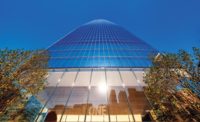NYC Skyscraper Is First U.S. Commercial Tower to Earn LEED Platinum

To date, One Bryant Park is the only commercial high-rise building in the U.S. to achieve LEED Platinum.
Photo © David Sundberg/ESTO
Architects & Firms
Last week, two years after its first occupants moved in, the owners of the 55-story office tower at New York City’s One Bryant Park celebrated the building’s official opening with a reception in the lobby. The “opening” party, attended by several hundred guests, coincided with the announcement that the 1,200-foot-tall, approximately $2 billion skyscraper had achieved Platinum certification under the U.S. Green Building Council’s LEED Core & Shell rating system. To date, it is the only commercial high-rise building in the U.S. to achieve this status.
Designed by Cook+Fox Architects, and jointly owned by the lead tenant, the Bank of America, and the developer, the Durst Organization, the faceted and tapered 2.1-million-square-foot tower deploys a host of highly integrated strategies that helped it win the highest possible level of LEED certification. Its features include daylighting maximized by a high-performance all-glass skin, rainwater and greywater recycling, and an advanced air filtration system.
Bank of America employees started working in their 1.6 million square feet of offices (with interiors designed by Gensler) in May 2008, when the top and the base and of the skyscraper were still under construction: Its 256-foot-tall spire would not be put in place for several more months, and the lobby would remain unfinished until last fall. The phased completion, planned before groundbreaking in summer 2004, was necessary according to the owners, so that the bank could start occupying the building as soon as its lease on space elsewhere in Midtown Manhattan expired.
Until last month, some signs of ongoing work remained. For instance, sidewalk bridging was kept up while workers replaced glazing that had been damaged during construction. But now the glass is installed and the temporary protection has been removed. And although passersby and even occupants are likely unaware, a key building system, a 4.6-megawatt natural gas-fired cogeneration plant, has only recently come on line. The plant, working in concert with an ice storage system, is expected to reduce the tower’s daytime peak energy demand by 30 percent.



